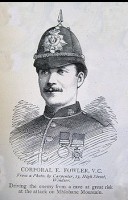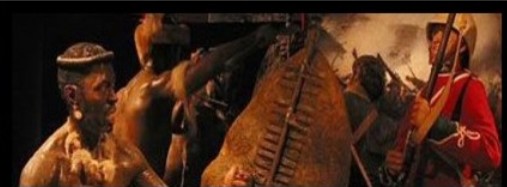| Latest topics | » William Jones Comment Tue Oct 22, 2024 11:31 pm by Eddie » Isandhlwana unaccounted for casualties Tue Oct 22, 2024 8:40 pm by JackFinn » Studies in the Zulu War volume VI now available Tue Oct 22, 2024 12:21 pm by Julian Whybra » Another Actor related to the Degacher-Hitchcock family Mon Oct 21, 2024 1:07 pm by Stefaan » No. 799 George Williams and his son-in-law No. 243 Thomas Newman Sat Oct 19, 2024 12:36 pm by Dash » Alphonse de Neuville- Painting the Defence of Rorke's Drift Fri Oct 18, 2024 8:34 am by Stefaan » Studies in the Zulu War volumes Wed Oct 16, 2024 3:26 pm by Julian Whybra » Martini Henry carbine IC1 markings Mon Oct 14, 2024 10:48 pm by Parkerbloggs » James Conner 1879 clasp Mon Oct 14, 2024 7:12 pm by Kenny » 80th REG of Foot (Staffords) Sun Oct 13, 2024 9:07 pm by shadeswolf » Frontier Light Horse uniform Sun Oct 13, 2024 8:12 pm by Schlaumeier » Gelsthorpe, G. 1374 Private 1/24th / Scott, Sidney W. 521 Private 1/24th Sun Oct 13, 2024 1:00 pm by Dash » A Bullet Bible Sat Oct 12, 2024 8:33 am by Julian Whybra » Brothers Sears Fri Oct 11, 2024 7:17 pm by Eddie » Zulu War Medal MHS Tamar Fri Oct 11, 2024 3:48 pm by philip c » Ford Park Cemetery, Plymouth. Tue Oct 08, 2024 4:15 pm by rai » Shipping - transport in the AZW Sun Oct 06, 2024 10:47 pm by Bill8183 » 1879 South Africa Medal named 1879 BAR Sun Oct 06, 2024 12:41 pm by Dash » A note on Captain Norris Edward Davey, Natal Volunteer Staff. Sun Oct 06, 2024 12:16 pm by Julian Whybra » Isandlwana papers he,d by the RE museum  Sun Oct 06, 2024 6:06 am by 90th » An Irish V.C. conundrum? Thu Oct 03, 2024 10:51 am by Julian Whybra » William Moore / William Potter 24th Regiment Thu Sep 26, 2024 3:04 pm by Dash » Stalybridge men in the 24th Thu Sep 26, 2024 2:24 pm by Dash » Grave of Henry Spalding Wed Sep 25, 2024 3:24 pm by Kenny » Thomas P Kensole and James J Mitchell Mon Sep 23, 2024 4:04 pm by Samnoco » flocking stands to historical accuracy Sun Sep 22, 2024 8:05 pm by GCameron » Private 25B/483 Joseph Phelan 1/24th Regiment Fri Sep 20, 2024 5:22 pm by Dash » Updated list of Zulu War Veterans who came to Australia or New Zealand Fri Sep 20, 2024 12:31 am by krish » A story regarding Younghusband's charge. Hearsay or a possibility?  Thu Sep 19, 2024 3:26 pm by Julian Whybra » Nine of the 24th Thu Sep 19, 2024 10:24 am by Julian Whybra » Colour Sergeant 2296 James Hannon Hawkins Thu Sep 19, 2024 8:00 am by Samnoco » S.S. Solway Campbell/O'Keefe/Quigley 24th Regiment Wed Sep 18, 2024 8:56 pm by Dash » Private 25B/2185 Owen Salmons alias Martin MacNamara? 1/24th Wed Sep 18, 2024 8:44 pm by Bill8183 » Fort Evelyn and the grave of the 58th Regiment Drum Major Sun Sep 15, 2024 5:59 pm by 1879graves » Telescope v. field glasses Sun Sep 15, 2024 10:20 am by 90th |
| October 2024 | | Mon | Tue | Wed | Thu | Fri | Sat | Sun |
|---|
| | 1 | 2 | 3 | 4 | 5 | 6 | | 7 | 8 | 9 | 10 | 11 | 12 | 13 | | 14 | 15 | 16 | 17 | 18 | 19 | 20 | | 21 | 22 | 23 | 24 | 25 | 26 | 27 | | 28 | 29 | 30 | 31 | | | |  Calendar Calendar |
|
| Top posting users this month | |
| New topics | » Isandhlwana unaccounted for casualties Tue Oct 22, 2024 8:40 pm by JackFinn » No. 799 George Williams and his son-in-law No. 243 Thomas Newman Fri Oct 18, 2024 5:05 pm by Dash » Another Actor related to the Degacher-Hitchcock family Fri Oct 18, 2024 8:54 am by Stefaan » James Conner 1879 clasp Mon Oct 14, 2024 8:54 am by peterconner » Frontier Light Horse uniform Sun Oct 13, 2024 8:12 pm by Schlaumeier » 80th REG of Foot (Staffords) Sun Oct 13, 2024 7:39 pm by shadeswolf » Gelsthorpe, G. 1374 Private 1/24th / Scott, Sidney W. 521 Private 1/24th Sun Oct 13, 2024 1:00 pm by Dash » Martini Henry carbine IC1 markings Sat Oct 12, 2024 11:03 am by Parkerbloggs » Alphonse de Neuville- Painting the Defence of Rorke's Drift Thu Oct 10, 2024 10:14 am by Stefaan |
| Zero tolerance to harassment and bullying. | |
Due to recent events on this forum, we have now imposed a zero tolerance to harassment and bullying. All reports will be treated seriously, and will lead to a permanent ban of both membership and IP address.
Any member blatantly corresponding in a deliberate and provoking manner will be removed from the forum as quickly as possible after the event.
If any members are being harassed behind the scenes PM facility by any member/s here at 1879zuluwar.com please do not hesitate to forward the offending text.
We are all here to communicate and enjoy the various discussions and information on the Anglo Zulu War of 1879. Opinions will vary, you will agree and disagree with one another, we will have debates, and so it goes.
There is no excuse for harassment or bullying of anyone by another person on this site.
The above applies to the main frame areas of the forum.
The ring which is the last section on the forum, is available to those members who wish to partake in slagging matches. That section cannot be viewed by guests and only viewed by members that wish to do so. |
| Fair Use Notice | | Fair use notice.
This website may contain copyrighted material the use of which has not been specifically authorised by the copyright owner.
We are making such material and images are available in our efforts to advance the understanding of the “Anglo Zulu War of 1879. For educational & recreational purposes.
We believe this constitutes a 'fair use' of any such copyrighted material, as provided for in UK copyright law. The information is purely for educational and research purposes only. No profit is made from any part of this website.
If you hold the copyright on any material on the site, or material refers to you, and you would like it to be removed, please let us know and we will work with you to reach a resolution. |
|
| | Shots fired at Rorkes Drift |  |
| | | Author | Message |
|---|
old historian2

Posts : 1093
Join date : 2009-01-14
Location : East London
 |  Subject: Shots fired at Rorkes Drift Subject: Shots fired at Rorkes Drift  Wed Sep 23, 2009 9:30 pm Wed Sep 23, 2009 9:30 pm | |
| I know we have covered this before, But who's says 25.000 rounds were fired at Rorkes Drift. How do we know there were 25,000 rounds there in the first place? And by what I have been reading about the Martini Henry, it didn’t seem capable of fire continually. I just find it hard to believe that many round were fired. |
|   | | littlehand

Posts : 7076
Join date : 2009-04-24
Age : 56
Location : Down South.
 |  Subject: Re: Shots fired at Rorkes Drift Subject: Re: Shots fired at Rorkes Drift  Wed Sep 23, 2009 9:50 pm Wed Sep 23, 2009 9:50 pm | |
| This old Chestnut.
Mark I and II Infantry Rifles, and Cavalry Carbine MkI's would have been the most prolific weapons on the British side during the 1879 Anglo Zulu War. The large, heavy .45 caliber bullets of the Martini-Henry inflicted horrific wounds on the attacking Zulus, and many who limped off the battlefield with bullet wounds died an agonizing, painful, slow death. At Isandlhwana and Rorke's Drift, it is presumed that volley firing commenced at a range of about 400 yards. At this range, the volley firing cut large swaths into the advancing line of Zulu warriors. Considering bullet weight and velocity, it is probable that many rounds fired from 200 yards or less went through one Zulu Warrior, and possibly onto a next, severely wounding or killing him as well. It is estimated that between 20,000 and 25,000 rounds were fired during the defense of Rorke's Drift, the vast majority of the shots having missed their targets altogether. Per Lt. Chard's report, the number of Zulu dead buried by the British was 351. It is estimated that another 300 Zulus died later as a result of wounds sustained during the battle. So, conservatively speaking, every 25th shot fired by the defenders of Rorke's Drift resulted in an eventual Zulu death, and every 50th shot was an outright kill.
In general, the Martini-Henry performed well during the Zulu War. It is the contention of some that chronic jams and cartridge feeding problems with the M-H were a contributing factor to the defeat of the men at Isandlhwana. I personally feel this theory to be lacking in factual evidence. While the occasional jam was a fact of life with black powder cartridge arms (moreso if the weapon is being rapidly fired, such as at Rorke's Drift), the M-H performed extremely well if properly cared for. The men who designed the M-H were not idiots, and would not have let a design flaw such as chronic jamming go unnoticed. It was during the Boer War that it became obvious that the large caliber, black powder Martini-Henry was obsolete. Facing small caliber magazine loading weapons, the Martini was clearly outclassed. |
|   | | ADMIN

Posts : 4358
Join date : 2008-11-01
Age : 65
Location : KENT
 |  Subject: Re: Shots fired at Rorkes Drift Subject: Re: Shots fired at Rorkes Drift  Thu Sep 24, 2009 9:44 am Thu Sep 24, 2009 9:44 am | |
| From: The victorian war Forum. Mike Snook say's - Quote :
- Its an urban myth that there were only a few hundred rounds left after the battle. The men's pouches were chock-full following a full scale replenishment.
|
|   | | | | Shots fired at Rorkes Drift |  |
|
Similar topics |  |
|
| | Permissions in this forum: | You cannot reply to topics in this forum
| |
| |
| |
